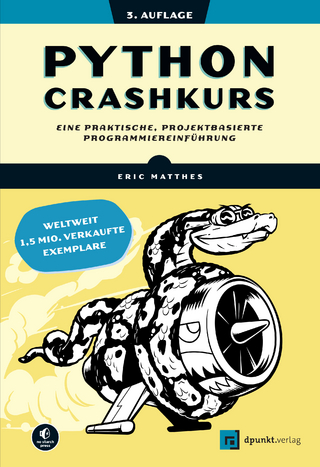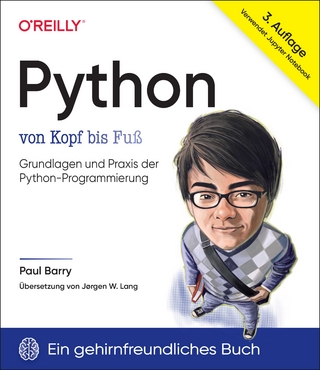
Python for Kids
No Starch Press,US (Verlag)
978-1-59327-407-8 (ISBN)
- Lieferbar (Termin unbekannt)
- Versandkostenfrei innerhalb Deutschlands
- Auch auf Rechnung
- Verfügbarkeit in der Filiale vor Ort prüfen
- Artikel merken
Python is a powerful, expressive programming language that's easy to learn and fun to use! But books about learning to program in Python can be kind of dull, gray, and boring, and that's no fun for anyone. Python for Kids brings Python to life and brings you (and your parents) into the world of programming. The ever-patient Jason R. Briggs will guide you through the basics as you experiment with unique (and often hilarious) example programs that feature ravenous monsters, secret agents, thieving ravens, and more. New terms are defined; code is colored, dissected, and explained; and quirky, full-color illustrations keep things on the lighter side. Chapters end with programming puzzles designed to stretch your brain and strengthen your understanding. By the end of the book you'll have programmed two complete games: a clone of the famous Pong and "Mr. Stick Man Races for the Exit"-a platform game with jumps, animation, and much more.
As you strike out on your programming adventure, you'll learn how to: * Use fundamental data structures like lists, tuples, and maps * Organize and reuse your code with functions and modules * Use control structures like loops and conditional statements * Draw shapes and patterns with Python's turtle module * Create games, animations, and other graphical wonders with tkinter Why should serious adults have all the fun? Python for Kids is your ticket into the amazing world of computer programming.
Jason R. Briggs has been a programmer since the age of eight, when he first learned BASIC on a Radio Shack TRS-80. Since then he has written software professionally as a developer and systems architect and served as Contributing Editor for Java Developer's Journal. His articles have appeared in JavaWorld, ONJava and ONLamp. Python for Kids is his first book.
Learning to Program
Chapter 1 Not All Snakes Slither
A Few Words About Language
Installing Python
Once You’ve Installed Python
Saving Your Python Programs
What You Learned
Chapter 2 Calculations and Variables
Calculating with Python
Variables Are Like Labels
Using Variables
What You Learned
Chapter 3 Strings, Lists, Tuples, and Maps
Strings
Lists Are More Powerful Than Strings
Tuples
Python Maps Won’t Help You Find Your Way
What You Learned
Programming Puzzles
Chapter 4 Drawing with Turtles
Using Python’s turtle Module
What You Learned
Programming Puzzles
Chapter 5 Asking Questions with if and else
if Statements
if-then-else Statements
if and elif Statements
Combining Conditions
Variables with No Value—None
The Difference Between Strings and Numbers
What You Learned
Programming Puzzles
Chapter 6 Going Loopy
Using for Loops
While We’re Talking About Looping . . .
What You Learned
Programming Puzzles
Chapter 7 Recycling Your Code with Functions and Modules
Using Functions
Using Modules
What You Learned
Programming Puzzles
Chapter 8 How to Use Classes and Objects
Breaking Things into Classes
Other Useful Features of Objects and Classes
Initializing an Object
What You Learned
Programming Puzzles
Chapter 9 Python’s Built-in Functions
Using Built-in Functions
Working with Files
What You Learned
Programming Puzzles
Chapter 10 Useful Python Modules
Making Copies with the copy Module
Keeping Track of Keywords with the keyword Module
Getting Random Numbers with the random Module
Controlling the Shell with the sys Module
Doing Time with the time Module
Using the pickle Module to Save Information
What You Learned
Programming Puzzles
Chapter 11 More Turtle Graphics
Starting with the Basic Square
Drawing Stars
Drawing a Car
Coloring Things In
A Square-Drawing Function
Drawing Filled Squares
Drawing Filled Stars
What You Learned
Programming Puzzles
Chapter 12 Using tkinter for Better Graphics
Creating a Clickable Button
Using Named Parameters
Creating a Canvas for Drawing
Drawing Lines
Drawing Boxes
Drawing Arcs
Drawing Polygons
Displaying Text
Displaying Images
Creating Basic Animation
Making an Object React to Something
More Ways to Use the Identifier
What You Learned
Programming Puzzles
Bounce!
Chapter 13 Beginning Your First Game: Bounce!
Whack the Bouncing Ball
Creating the Game Canvas
Creating the Ball Class
Adding Some Action
What You Learned
Chapter 14 Finishing Your First Game: Bounce!
Adding the Paddle
Adding an Element of Chance
What You Learned
Programming Puzzles
Mr. Stick Man Races for the Exit
Chapter 15 Creating Graphics for the Mr. Stick Man Game
Mr. Stick Man Game Plan
Getting GIMP
Creating the Game Elements
What You Learned
Chapter 16 Developing the Mr. Stick Man Game
Creating the Game Class
Creating the Coords Class
Checking for Collisions
Creating the Sprite Class
Adding the Platforms
What You Learned
Programming Puzzles
Chapter 17 Creating Mr. Stick Man
Initializing the Stick Figure
Turning the Stick Figure Left and Right
Making the Stick Figure Jump
What We Have So Far
What You Learned
Chapter 18 Completing the Mr. Stick Man Game
Animating the Stick Figure
Testing Our Stick Figure Sprite
The Door!
The Final Game
What You Learned
Programming Puzzles
Appendix Where to Go from Here
Games and Graphics Programming
Programming Languages
Final Words
Appendix Python Keywords
Glossary
Updates
| Erscheint lt. Verlag | 12.12.2012 |
|---|---|
| Zusatzinfo | illustrations |
| Verlagsort | Daly City, California |
| Sprache | englisch |
| Maße | 180 x 234 mm |
| Gewicht | 635 g |
| Einbandart | geklebt |
| Themenwelt | Kinder- / Jugendbuch ► Sachbücher ► Naturwissenschaft / Technik |
| Informatik ► Programmiersprachen / -werkzeuge ► Python | |
| ISBN-10 | 1-59327-407-6 / 1593274076 |
| ISBN-13 | 978-1-59327-407-8 / 9781593274078 |
| Zustand | Neuware |
| Haben Sie eine Frage zum Produkt? |
aus dem Bereich


